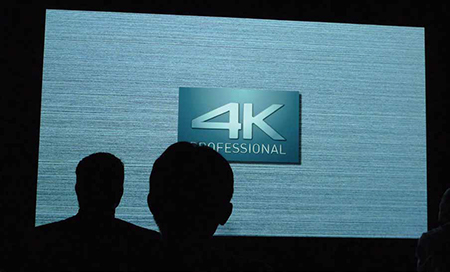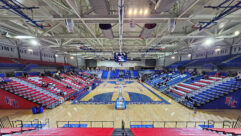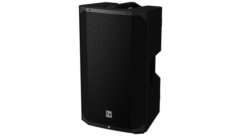

For four years running, the big spring tradeshows and conferences (NAB, CinemaCon, InfoComm) have featured high-profile panels and sessions on the projector wars at the high end of the market; a shoot-out of sorts of the big large-venue projection manufacturers—and with a lot of attention was paid to the sexy part of the market, the cinema market. This commentator has covered those events extensively, and this year a lot was at stake as new projection technologies came on line. To top it off, a smaller boutique event toward the end of the summer—the NewBay Media Rental & Staging Roadshow—was both a great follow-up to those earlier events and different take on the big issues from a different perspective.
The Roadshow that took place in New York at the end of July included a full day of panels, presentations, gear exhibits, and networking for a couple hundred industry professionals. Including 3D projection mapping and integrating social media in live events, the day’s lineup provided something for just about anyone in the staging/live event community. But it’s rapidly evolving story of the big-gun projectors that’s the most gripping story this year, and so it was at the Manhattan Roadshow.

(From left to right) Barco’s Bill Beck, Jeff Schneider from Digital Projection, Jeff Lawson of Panasonic, and Mike Garrido from Christie, at the Large Venue Projection panel at the July 29 Roadshow in New York City.
No need here to replay all the details the ongoing Barco vs Christie cinema market shootout—in fact the Roadshow panels did not dwell on those dynamics that are fairly established: Barco and Christie have settled into market alliances on the premium cinema side (Barco with IMAX; Christie with Dolby) and sole-provider cinema product niches in which they seem comfortable. With Barco and Christie DLP Cinema projectors, we’re still talking pure laser projectors, not laser phosphor. (Pure laser projectors are not at all ready for the staging market. There are still government regulations that prohibit the big laser projectors from being used in a live event today, but change is coming there as well, eventually.) Yes, for cinema, NEC has its laser phosphor solution that they’ve been selling into the smaller screen market and pro AV market since last year, and now Barco is trying to introduce laser phosphor into the cinema market, but for big-screen cinema, the big story is still pure laser engine, not laser phosphor.
For the Roadshow attendees, i.e. staging pros doing big live events, it’s not about getting the perfect image or the perfect projector to put up full DCSI spec images, and work on autopilot for months. It’s about getting a great projector and getting it to max out its specs and its performance for the duration of a two-hour show (OK, a string of two-hour shows). In this world—especially super-high-end shows like the Olympics, Super Bowl shows, and top-level rock and country music tours—it’s almost always about stacking a whole bunch of projectors to get even more lumens (as well as back up for individual lamp failure) out of 30K to 50K-lumen projectors. 4K is now commonplace—4K from one projector that is, even though with tiled projectors you can get 4K, 8K, or whatever resolution you want if you have enough screen real estate. Pixel mapping is the new normal for larger budget live events, especially ones that are not necessarily all on one stage but, for example, use an entire side of a building or the floor of an arena as a pixel-mapped screen. In fact the Roadshow saw all the representatives from the high-lumen projection manufacturers—Barco, Christie, Digital Projection, and new to the Roadshow this year, Panasonic—show examples of some very sophisticated pixel mapping using their projectors.


Panasonics’s PT-DZ21KU projector in a projection mapping display onto a Tesla Model S sports car.
Key to understanding the live event market: Unlike installed AV and even cinema, where the TCO (total cost of ownership) of projectors gets pricey when you factor in all the lamp replacements you’ll need in one projector’s life span, in the live event market, you are not running projectors in brutal near-24/7 fashion. So lamp replacement is not a big deal, right? Well, this is where it starts getting interesting. The first big trend there? As Jeff Schneider of Digital Projection pointed out in his presentation at the Roadshow, we are seeing a trend toward more mercury/UHP lamps and away from so many projectors based on Xenon lamps. Xenon lamps feature great color spectrum, but they are less efficient in terms of energy use, and they have a relatively short lamp life. But yes, Xenon lamps put out more lumens, and they have been the gold standard for a while, to achieve the best image. Mercury/UHP lamps, on the other hand, are less expense to replace (each lamp), have a longer lamp life, and generate less heat. Mercury/UHP lamps are not as bright at the upper ranges, but they can put out up to 25,000 ANSI lumens. The result of these differences? More mercury/UHP lamp-based projectors being used for live events and less Xenon lamp-based projectors. Xenon lamps can produce a better color range than the UHP type lamps, and they use Xenon, not mercury, as the inert gas in the lamp envelope. However, starting at more than $1,000 each and with a typical life span of 500 to 1500 hours, Xenon lamps tend to be significantly more expensive and have a shorter life than most UHP lamps. In comparison, UHP lamps have a typical life span between 1500 to 3000 hours and tend to cost an average of $500 each.
Of course, both systems are still very much alive in the staging world. In fact, together, they still dominate. But according to several of the panelists, staging clients would prefer to double stack a couple of 20K-lumen projectors with mercury lamps in many staging situations for ease of use and also quietness.
But the real game changer for the large-venue projection market—and we’re talking here about the live event/large venue market, not cinema—is the introduction this year of new gen laser phosphor projectors for the pro AV market that heretofore has only seen lower-lumen laser phosphor projectors (in the 6K-7K-lumen range). At the high end of laser phosphor, InfoComm in June set the stage, with NEC showing new, brighter (12K lumen) laser phosphor. Barco had its new line of laser phosphor. Digital Projection demonstrated that it is broadening its line of laser phosphor to now offer not just 3-chip DLP laser phosphor (that they’ve had for a year or so) but also new 1-chip models (one at about 6500 lumens, and a brighter one at about 8500 lumens).
TCO is everything in the installed AV world, and the appeal of laser phosphor is obvious with laser phosphor projectors coming in at about 20,000 hours of “lamp” life. That improved TCO is money in the bank for the end-user, when they see that a single higher-lumen conventional lamp-based projector will use up to $20K in lamp replacements over its lifetime. But what about laser phosphor for the staging market? It’s here, now. And it will shake up the market, but not based on TCO issues alone.
At the Roadshow, Bill Beck of Barco pointed out that his company is pushing the envelope for laser phosphor, all the way up to 30K lumens. But Beck emphasized that “you have to provide benefits to the staging community, beyond the lamp-free TCO … like color.” In fact, Beck has been a great advocate in the industry for demonstrating that laser phosphor can deliver a broader color gamut, not just the lampless TCO benefit. Also it’s as much as about the luminance curve: with a metal halide lamp projector rated originally at 14,500 lumens, at 200 hours you lose 20 percent of brightness; and at 300 hours, it will be below 11,000 lumens. So laser phosphor means better color and brightness consistency over time as well as longer life span.

Digital Projection International’s 12,000-lumen INSIGHT 4K LASER enlists a 20,000 hour laser-hybrid illumination source. That equates to 10 years of illumination when run 40 hours/week, without a single lamp replacement…. bright, stable and color-accurate imagery with remarkably low lifetime costs of ownership. No lamps to purchase, replace and maintain. Unlimited tilt and pitch positions, allowing for unprecedented flexibility. And a chassis thatís approximately 40% of the size and weight of existing 4K high-brightness Xenon-illuminated projectors.
But isn’t the initial price of the new gen laser phosphor projector a lot higher, cancelling out the savings of no lamp replacement?
Jeff Schneider of Digital Projection commented that “at first, the laser phosphor cost a lot more,” and so you had to factor that in against the lamp replacement savings. “But recently,” Schneider says, “we can offer a lamp-free laser phosphor projector for just about $3K more than the lamped one … so you get the cost back with two lamp purchases.”
It was great to have Panasonic represented at the Roadshow. While its projectors have been a key part of the landscape for years, the company has not been as visible on the very high lumen side, as have Barco, Christie, and Digital Projection. But with these trends were seeing, Panasonic should be right in the mix. Jeff Lawson of Panasonic gave the Roadshow attendees a primer on Panasonic, from its purchase of Sanyo a few years back, to the introduction of laser phosphor projectors at InfoComm in June. Panasonic’s new Solid Shine series, 3-chip laser phosphor, offers projectors in 6K-20K lumens. Dawson explained that since TI does not make a 4K chip in .95in. size, Panasonic developed its “quad pixel drive” using a WQXGA chipset. (The Panasonic booth at InfoComm showed that PT-RQ13KU projector, a “beyond 4K” screen resolution projector, that has 10,000 lm of brightness and a contrast ratio of 20,000:1. The projector’s pixel is shifted both horizontally and vertically at a high frame rate of 240Hz, physically creating four different pixels from a single pixel, effectively quadrupling the pixel density of the image.)
I can’t imagine that 2016 will see any less revolutionary developments in large-venue projection. Just shaking out all the changes in laser phosphor alone will keep us all on our toes. (Will Christie, a projector company owned by a lamp company, go down the laser phosphor path as well?). And it’s a sure bet that conventional lamp projectors—still the mainstay of the staging market—will see continued innovations such as pushing Xenon to the limit as Christie didwith its Boxer series projectors this year. And will Barco really get laser phosphor projectors up to 30K lumens in 2016? It will be a wild ride until next spring’s new round of shoot-outs.










